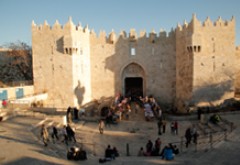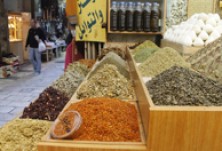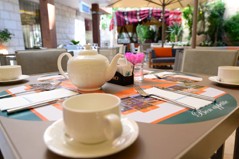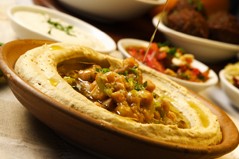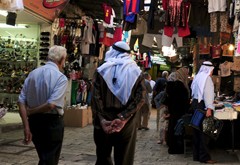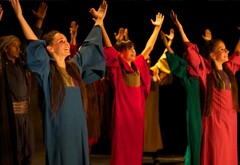In the past, the street extended west along al-Khanqah al-Salahiyya road until a few meters after the entrance to Haralambos Monastery, where one of the entrances to the Holy Sepulcher was. This entrance was closed and later blocked. Today, to reach the ninth station which leads to the Holy Sepulcher, one has to backtrack from al-Khanqah al-Salahiyya road and go east, turn right (south) at the seventh station in Khanal- Zait Street, walk a few meters after ‘Aqabat Al-Takiyya junction, ascend the steps to the Coptic Monastery to the west of Khan al-Zait Road, and follow the stairs to the road leading to the ninth station and to Deir al-Sultan, where the roof of St. Helena’s church is. On the southwest side of Deir al-Sultan, a door leads to the entrance of the Holy Sepulcher, passing through the Four Knights church and the Angel church, both disputed by the Coptic and Ethiopian sects.
Importance of the Holy Sepulcher
The Holy Sepulcher is the most important church in Jerusalem, and in the world for that matter. It was built during the Byzantine period and is in the heart of the Old City of Jerusalem. The church has been a destination for pilgrims from all over the world since the 2nd century. It is the place where Jesus Christ was crucified, tortured, suffered, died, and was resurrected, and where his tomb is, according to Christian scriptures and beliefs. It is a unique church and belongs to all Christian sects; the large architectural complex comprises a number of small churches, with a total area of over 5,000 square meters.
Holy Sepulcher’s Founder, Architect and Components
All Christian sects, with the exception of one, small Protestant group headed by General Gordon, agree that Christ was buried and resurrected at the present location of the Holy Sepulcher. The Church was built by Emperor Constantine and his mother Helena, where Constantine sent an engineer called Zenobius, a Palmyran, to build the Holy Sepulcher. He started construction in the year 326 AD, and when the church was inaugurated in 335 AD, it comprised four basic architectural elements: an advance atrium accessed through three doors preceded by a staircase, a basilica composed of five aisles and one nave, an open courtyard and garden in whose southeast corner Christ is thought to have been crucified (Golgotha), and the Holy Sepulcher (Holy Tomb) in the middle of a rotunda. The Bishop of Jerusalem adorned the tomb, then added an aisle in the year 384, after the inauguration.
Caliph Umar Ibn al-Khattab and the Holy Sepulcher
The Persians destroyed and burnt down the Holy Sepulcher in 614, along with other churches in Palestine, which instigated the Patriarch Modestus to head to Constantinople and strive to rebuild it, though at a smaller scale, but without any major change. The Muslim Caliph Umar Ibn al-Khattab turned down a proposal by the Patriarch Sophronius to pray in the Holy Sepulcher when the call for prayer was made while he was inside the church, so that Muslims would not do the same and take over the church later on. He went outside and prayed in an open space, where a mosque was built later, carrying his name.
Al-Hakim Orders the Destruction of the Church and the Franks Rebuild it
Christians later suffered from the haphazard policy of the Fatimid Caliph al-Hakim ai Amr allah (996-1021 AD / 386-411 H), alongside all sectors of the Islamic community in Palestine and Egypt. The peak of suffering and hassle was when he ordered the governor to destroy the Church of the Holy Sepulcher in 1009 AD / 400 H, but he soon changed his mind, as was typical of his erratic behavior, and allowed its rebuilding. His son, al-Zahir, also allowed the rebuilt the Holy Tomb in 1027 AD / 418 H. During the Franks’ control of Jerusalem and Palestine, they carried out amendments and additions to the Holy Sepulcher, culminating in a major project that majorly changed the plan of the Constantine Church, including the construction of a new church in 1149 AD known as the Catholicon, along the Romanesque style, with a dome overlooking the Tomb Rotunda. The Crucifixion site was brought inside the church building, and its lower part was made into a cemetery for some Frank kings. In 1170 AD, a tower was added for the church bells in front of the entrance, which was designed to open south instead of east. Despite this major change in the church plan, the Holy Sepulcher maintained its main elements of holiness, represented in the Holy Tomb and the Crucifixion site.
Saladin the Organizer
This development of the Holy Sepulcher is what Salah al-Din witnessed after liberating Jerusalem from the Franks in 1187 AD / 583 H. Salah al-Din followed the footsteps of Caliph Umar Ibn al-Khattab in his tolerance and understanding of Christians and their rights, particularly eastern sects. He preserved churches, including the Holy Sepulcher, in accordance with prevailing Shari’a laws at the time and previous agreements concluded by the Caliph Umar Ibn al-Khattab and approved and adopted by Muslim caliphs and sultans. He also took preventive measures, such as closing the eastern gate of the church and restricting entry to the western gate, transferring the Patriarch’s house into a Sufi Khanqah (a place of worship, meditation and learning) known as the Salahiyya Khanqah, and assigning the task of keeping the Holy Sepulcher’s keys and opening and closing its door, morning and evening, to notable Jerusalem families like Nusseibah and Ghadiyah (Joudeh).
Visiting the Church
Entrance
The Church’s double-door opening to the south leads into an atrium. It is a grand door, two floors high, the first part of which comprises two openings, with the northern one blocked. Above each is a huge lintel with carved inscriptions depicting events in the Christian faith. These lintels have been moved to the Palestinian Rockefeller Museum.
The Golgotha
Entering the church, the visitor finds a modern staircase to the right (north) leading to the crucifixion site. The top of the rock is about five meters above the entrance level, and the area is divided into two parts, eastern and western, with a small chapel in each. The level and concentration of ornaments indicate the difference between the Eastern Orthodox Church and the Western Catholic Church. The eastern part is the property of the Roman Catholic sect, and at its northern end is the Altar of the Crucifixion, ornamented with an embossed copper engraving. This altar dates back to 1588 AD and originated in the city of Florence in Italy. The walls and ceiling are adorned with mosaics depicting Christian events and concepts. The mosaics were created in 1937 AD except for some ceiling ornaments, which are from the Franks era in the 12th century. On the western Greek side, the remaining part of the crucifixion rock can be seen behind glass, with a crack that took place, according to Christian tradition, when Jesus Christ died after being stabbed by the Roman soldiers and stripped naked. Stripping Christ represents the 10th station of Via Dolorosa. Fixing Christ on the Cross with nails represents the 11th station. The 12th is his death, the 13th is taking His body down from the Cross, and the last is placing His body in the Tomb.
Chapel of Adam and Stone of The Anointing
A descending staircase facing the ascending one leads to the Stone of The Anointing and Chapel of Adam, named according to the common tradition that Christ died where Adam was buried. At the end of this Greek Orthodox Church is a deep nave with a round dome, behind which is part of the Crucifixion Rock with a crack. A door in the western wall of the Chapel of Adam leads to the Stone of The Anointing, where Christ was washed before He was buried. Eight lanterns are placed above this rock, four of which (with gilded eggs) are for the Greek Orthodox sect, two for the Armenian sect, one for the Roman Catholic and one for the Coptic sect. On each side of the rock’s ends are three candle stands, one on each side for the Greek Orthodox, one for the Armenians and one for the Roman Catholics. To the west of the purple Stone of The Anointing is a stone wall, separating the entrance from the Catholicon Church. The lower part of the Stone of The Anointing was recently adorned with mosaics depicting the crucifixion, taking Christ down from the cross and preparation for his burial. To the west is the Armenian chapel, and the Three Mary’s altar is to its right.
The Holy Tomb
Turning slightly right reveals the Holy Tomb, located under a large rotunda resting on a group of pillars carrying a circular dome, at the center of which is an opening allowing a ray of sunlight into an otherwise dark space. The dome is adorned with twelve gilded petals, representing Christ’s twelve disciples. From the outside, the dome is a prominent feature of Jerusalem’s skyline, together with the gilded Dome of the Rock, though the latter is gilded in its entirety but only the cross on the Holy Sepulcher dome is gilded. The Church of the Holy Sepulcher includes many small chapels, rooms, halls and praying niches, as well a large number of archaeological artifacts and sites around the Holy Sepulcher related to the Constantine Church.

